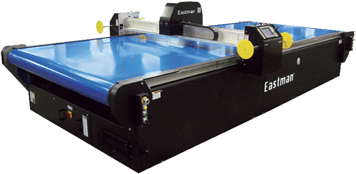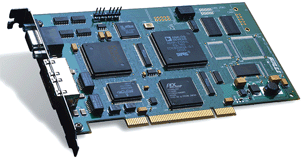By Dean Onishi
Dean Onishi is the SynqNet Communications Manager, Danaher Motion
Eastman Machine (Buffalo, NY) builds equipment that ranges from manually-operated cutting machines to fully automated cutting systems. The latest model in the company’s diverse fleet is the Eagle C3—a fast, accurate, and durable, automated conveyor cutting system with a user-friendly touch screen interface and self-monitoring capabilities.
For the composite and industrial fabric markets, the Eagle C3 can cut just about any type of material including carbon fiber, upholstery, foam, vinyl, fiberglass, mesh, canvas, carpet, and rugged safety materials like Kevlar. The machine offers one of the largest cutting surface areas in its class with table widths to 4 m (156 in). When combined with the conveyor feeder that can draw material from the roll feeder across the table cutting surface at up to 40 cm/s (16 in./s), there is almost no limit to the maximum length of a cut piece, which is essential for cutting large sails, pool covers, and awnings.

The addition of a digital network, SynqNet, let Eastman engineers develop cutting machines for easy, custom configuration.
The standard Eagle C3 model features an X-Y-Z gantry system with five motion axes, three SynqNet Slice I/O nodes for analog and digital I/O, and a vacuum conveyor system for distributing the roll material over the cutting surface. It uses high-resolution encoders and an XMP-SynqNet-PCI motion controller from Danaher Motion for precise motion control.
The machine also uses self-calibration routines during initialization where the tool head moves around the table and checks home limits and table dimensions. Eastman’s eCAD design workspace is for designing almost any type of pattern. The eNest nesting application software determines the optimal layout for material usage.
Eastman’s goal was to build an automated cutting machine that would satisfy almost any customers’ performance and flexibility requirements. Previous Eagle machines had limited capabilities because of an inflexible architecture and an analog motion controller. The machines required large numbers of cables, which made them difficult to customize and troubleshoot. Robotic System Integration (RSI), a value-added reseller of PC-based networked motion control systems, partnered with Eastman and suggested that the company use SynqNet, an all digital motion network, to help meet these goals.
The earlier analog machine versions had 14 to 20 cables for power, serial communication and controller I/O, and custom cables for discreet I/O. Because the analog motion controller and amplifiers were installed in an enclosed control box outside the machine, over 1000 ft of cable was needed for the long cable runs between the two units.
The all-digital SynqNet network, though, has a large data bandwidth to manage all system level control and support both motion control and I/O.
Its flexibility let the engineers create a motion network with central control and distributed hardware, which let them place discrete I/O modules in convenient locations to shorten cable runs. For example, the Eagle C3 has SynqNet Slice I/O modules mounted next to the sensors. This configuration reduced the total cable length by 80%.

The all-digital SynqNet network, from Danaher Motion, has a large data bandwidth to manage all
system level control and support both motion control and I/O.
Because of the variety of materials these machines cut, they had to be easy to configure to meet customer requests and modifications. In previous designs, the non-networked controls architecture impeded custom work.
Currently, SynqNet supports up to 32 nodes with up to 32 axes of motion and over 16,000 bits of digital I/O or 1,000 points of analog I/O. “Adding an additional axis for a customer is no longer a problem,” explains Paul Wilkins, chief technology officer. To add a custom labeler or separate punch to the main head unit, an engineer simply adds another node to the SynqNet network.
The network’s interoperability let the engineers choose the servo amplifier and motor manufacturer of their choice. Then they connected a SynqNet drive to the network, and the SynqNet motion controller automatically runs through initialization and setup routines.
Eastman also used the RapidSetup utility from RSI to set up the machines in less time by using a single, seamless interface to configure each drive on the network. Eastman’s eCut Windows
motion control software, developed using the SynqNet RapidCode API from RSI, eases motion control programming.
The C3 monitors itself and reports faults and alerts operators for maintenance. An error message and software tools pinpoint the exact location of a problem on the network.
SynqNet also makes it possible to troubleshoot the machine remotely. Through the Internet, a technician can access a customer machine and troubleshoot the problem remotely.
Unfortunately, even the most robust machines have hardware components and cables that will eventually degrade and fail over time. When configured in a ring topology, SynqNet becomes a fault tolerant “self-healing” network that allows a machine to remain fully operational even when there is a bad cable or broken link connection. Similarly, if power is lost to a drive, communication to other nodes is never lost.
For example, if there is a bad cable on the network between two drives, the network uses a redundant link to automatically reroute data packets around that cable allowing the motion controller to maintain communication to all nodes on the network. The machine remains fully operational despite the cable failure, which lets customers complete cutting routines without
interruption or material waste.
SynqNet also gives Eastman a more controlled emergency stop (E-Stop) function. During E-Stop in earlier models, communication was lost between the motion controller and drives, but motors could still receive power and torque commands from the amplifier and potentially ruin cutting material or damage hardware components. With SynqNet, communication is never lost between the motion controller and drives on the network. When all power is cut from the motors, network power is maintained.
Danaher Motion
www.danahermotion.com
:: Design World ::
Filed Under: Motion control • motor controls





Tell Us What You Think!